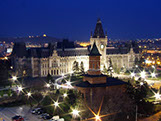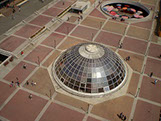







2018 Revival ARA Congress
ROMANIA AT THE GREATER UNION CENTENNIAL ANNIVERSARY
Invited Speakers
Petre Gheorghe Barlea
Professor Dr. Ovidius University Constanta, Romania
PRESENTATION: LITERARY ROMANIA AT THE BEGINNING
OF THE TWENTIETH CENTURY
Petre Gheorghe Barlea (b. 1951) is a graduate of the classical philology and modern philology program at the University of Bucharest, Romania, and has a PhD in general and comparative linguistic /Indo-European linguistics from the same university.
Areas of competence:
General and comparative linguistics; mythological linguistics; classical philology; rhetoric and stylistics; pragmatic analysis of literary texts; communication theory, intercultural dialogue, specific specialty languages; Romanian language - as a native and as a foreign language.
Educational and Professional positions:
Chair of the Department of Romanian Philology, Classical and Balkan Languages at "Ovidius" University of Constanta Romania; taught at universities in Targoviste, Romania, Prague, Czechoslovakia, Paris, France, Vienna, Romania, Ciudad Real, Mexico, and Cleveland, Ohio, USA.
He served as vice-rector, department chair, director of several departments, executive director of the Doctoral School; Doctor Honoris Causa, MDT; has coordinated several national and international scientific research projects since 2000; member on several occasions of ARACIS - The Romanian Agency for Quality Assurance in High Education; former and current member of CNATDCU - Consiliul National de Acordare a Titlurilor Academice si a Diplomelor Universitare –/ National Council for Offering Academic Titles and University Degrees, the philology committee; expert evaluator for academic research projects for UEFICDI - Unitatea Executiva Pentru Finantarea Invatamantului Superior a Cercetarii Dezvoltarii si Inovarii / The Executive Committee for offering funds for High Education, Research, Development, and Innovation.
The books he published books reflect some of current concerns: ”Contraria Latina-Contraria Romanica”, 1999; “Introduction to the Study of Christian Latin”, 2000; “Peithous Demiourgos. Greek-Latin rhetoric”Good , 2004; “Good Ana. Linguistics and mythology, 2007; “The language of the Romanian folk tales”, 2008; “Multilingualism and Interculturality”, 2010; “Translations and translators. Pages of Romanian Culture History”, 2016 and others . He was the coordinator of a “Dictionary of Imaginary Places....”, 2006; 2009.
Translations: A. Schopenhauer, “Dialectica eristica sau Arta de a avea întotdeauna dreptate”/ “The Art of All Right”, 2010. Text edited by E. Lovinescu, “O privire asupra clasicismului” / “A Look at Classicism”, 2012, L. Wald, “Progresul în limba” / “Progress in Language”, 2015 et al.
He is the founding director of Diversité et Identité Culturelle en Europe” (French) (DICE) /“Diversity and Cultural Identity in Europe”, 2004-.
Abstract of the talk:
Literary Romania At the Beginning of the Twentieth Century
Petre Gheorghe Barlea
Professor Dr. Ovidius University Constanta, Romania
Abstract: 1. As it is known, the so-called synchronic analysis of a language system is a methodological convention based on the pragmatic ignorance of the natural dynamics of any living language. A language is, by its human nature, in eternal diachronicity. It is enough to evoke the debates of the founders of comparative-historical methods, to understand that linguistics can only be historical, just as true philosophy can only be idealistic. In fact, by moving in time, our approach is already diachronic, as we try to see how the 1900s look from the perspective of 2018. A centuries-long interval provides a fairly generous perceptual and axiological field for a correct description. The problem is limiting language samples at a certain points in time, e.g., the decades that marked the birth of modern Romania, its broadest historical-geographical boundaries and its most comprehensive ethno-linguistic configuration. Therefore, from any perspective we look at things, even if we wanted, we could not diagnose the "linguistic time period", if there is such a thing, as stated in the title above.
2. The methodological framework we are using, however, aimed at finding a unity in diversity, trying to establish the manifestations of the language on the three dimensions that are taken into account in specialized analyzes: diachronic, diastatic, and diatopic. Diacronic, refers to the fact that the corpus of work was selected from texts published between 1904 and 1947. The first term is given by the first major Reformation of the Romanian spelling, endorsed by the Romanian Academy. For the term “ad quem”, we considered the debates at the Academy and what appeared on this topic in the pages of the periodicals in the field of study, and/or those of general information, from schools and universities, between 1916-1932 and 1947, which prepared the 1951 (1953) reform. In what Diastratic is concerned, the author searched the texts of opinion leaders and creative and cultural style creators, such as S. Puşcariu, D. Caracostea, N. Iorga, O. Goga, L. Blaga, T. Arghezi, on one hand, and P. Carp, and C-tin Argetoianu, on the other hand. The author also analyzed the texts available in the written press. Finally, the diatopic perspective imposed the selection of the texts in Great Romania (the Kingdom, including Moldavia on the East side of the river Prut), Transylvania, and Bessarabia.
3. Among specific phenomena, there are mainly trends and processes, not fixed rules:
3.1 In the class of the nouns, in literary Romanian, for terms expressing abstractions, first dominate forms ending in “-(ț)iunem”; however, free variations appear for the short form, and some terms caused great problems, until the form that remained valid for our language got established ( some exampled: „În chestia Cadrilaterului vs. chestiunea țărănească”, and „condițiune”, „populațiune”, etc.);
3.2 Also regarding nouns, there are still hesitations about G-D f form such as “țărei/țării”, “pacei/păcii”, etc.
3.3 In what the relative pronoun is concerned, the plural clearly dominates with a specialization attempt for the male plural, rather than the feminine plural “care”, before they are all reduced to the use of “care” for both singular and plural, masculine and feminine.
3.4 In the class of verbs, one should notice the frequency of the simple perfect - for. all the nuances of the past tense, with archaic phonethism: such as “cetii”, etc.
3.5 At lexical level, lexemes and constructions are common today, such as “la aparență (today: “la rigoare”, but “în aparență”), “clipă după clipă”, etc.
4. Therefore, despite the particularities exemplified above, we find in the present language most of the features of a hundred years ago. In other words, around 1918, Romanian was already a modern language, at the level of the historic events of that moment, able to embody perfectly the ideas and feelings that generated the birth of Great Romania.
Keywords: diacronic, diastratic, diatopic, Romanian language system





